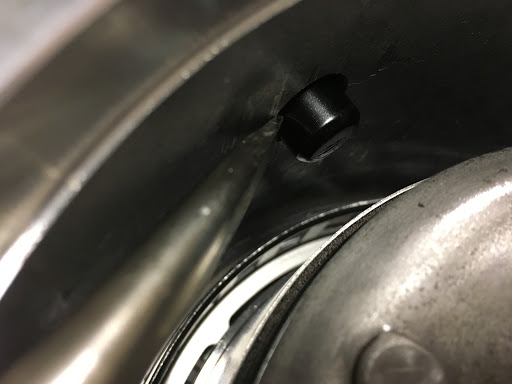gsbarry
Well-Known Member
- Joined
- August 6, 2008
- Messages
- 156
- Reaction score
- 12
- City, State
- Houston, TX
- Year, Model & Trim Level
- Stock 97 4.0 EB SOHC
Disassembly & Carnage Pics
Fist we remove the outer components - here we have the useless ((ODS) overdrive drum speed) sensor (basically a hole plug) for the E model. If you have been following this thread, the last rebuild replaced the OD planetary with a W/N/S version that has an additional reluctor ring. During the install I realized this sensor went unused, but we figured the new OD planetary gear actually would provide an ironically functioning signal.

However, when I took a close look this time (below) you will see that the position of the OD planetary reluctor (middle of pic) is much lower than the sensor (tip of screwdriver). The W/N/S must have the OD planetary position higher in the geartrain or possibly an additional reluctor on the OD drum.

Here is the (OSS) output shaft speed sensor - the reluctor for this one is part of the parking gear.

Here is the DTR (digital trans range) sensor - I made a chalk mark before removing the lever to make alignment on reinstall easier.

And HERE WE HAVE SOME CARNAGE - after removing the OD band and struts, then the OD drum, then the OD planetary, we are left with the center shaft and input sprag. You can see one of the teeth fell out right away, and the cage is bent and broken.

Fist we remove the outer components - here we have the useless ((ODS) overdrive drum speed) sensor (basically a hole plug) for the E model. If you have been following this thread, the last rebuild replaced the OD planetary with a W/N/S version that has an additional reluctor ring. During the install I realized this sensor went unused, but we figured the new OD planetary gear actually would provide an ironically functioning signal.
However, when I took a close look this time (below) you will see that the position of the OD planetary reluctor (middle of pic) is much lower than the sensor (tip of screwdriver). The W/N/S must have the OD planetary position higher in the geartrain or possibly an additional reluctor on the OD drum.
Here is the (OSS) output shaft speed sensor - the reluctor for this one is part of the parking gear.
Here is the DTR (digital trans range) sensor - I made a chalk mark before removing the lever to make alignment on reinstall easier.
And HERE WE HAVE SOME CARNAGE - after removing the OD band and struts, then the OD drum, then the OD planetary, we are left with the center shaft and input sprag. You can see one of the teeth fell out right away, and the cage is bent and broken.


 pump apart. A closer inspection of the tool - you can see the writing on the lip in the pic below - shows that it was in fact designed for a W-N-S version pump, not the E. I was under the impression that the W-N-S used the same torque converter as the E, and hence the pump shaft would be the same, but perhaps there is a slight difference, enough to give me the trouble I had. As you can see, I didn't drive the tool all the way down, anticipating that I would need to pull it back up by the lip - but it simply would not budge. I then proceeded to unbolt the pump and drive the shaft down through the housing, using a large socket to protect the tip of the shaft. Again it would not budge until I took the torch to the tool. I will have to find another tool that fits properly for reassembly.
pump apart. A closer inspection of the tool - you can see the writing on the lip in the pic below - shows that it was in fact designed for a W-N-S version pump, not the E. I was under the impression that the W-N-S used the same torque converter as the E, and hence the pump shaft would be the same, but perhaps there is a slight difference, enough to give me the trouble I had. As you can see, I didn't drive the tool all the way down, anticipating that I would need to pull it back up by the lip - but it simply would not budge. I then proceeded to unbolt the pump and drive the shaft down through the housing, using a large socket to protect the tip of the shaft. Again it would not budge until I took the torch to the tool. I will have to find another tool that fits properly for reassembly.




